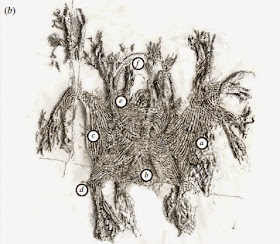The fossils of the Ediacaran Period record the first widespread
macrofossils in the rock-record. Many of these fossils do not appear to belong
to any modern group, but instead are thought to belong to an extinct taxa
(sometimes known as ‘Vendobionts’), which may-or-may-not be related to modern
Animals, though some fossils have been linked to Sponges (a group which also
has pre-Ediacaran potential members), Anthozoan, Hydrozoan and Scyphozoan Cnidarians,
Ctenophores, Placozoans, early Molluscs and even Ascidian Chordates. Most of
these potential members of modern groups are from the latest part of the
period, between 555 and 541 million years ago, when these groups are predicted
to have existed, but remain rather controversial.
In a paper published in the Proceedings of the Royal Society SeriesB; Biological Sciences on 27 August 2014, Alexander Liu of the Department of Earth Sciences at the University of Cambridge, Jack Matthews and Latha Menon of
the Department of Earth Sciences at the University of Oxford, Duncan McIlroy of
the Department of Earth Sciences at the Memorial University of Newfoundland and
Martin Brasier of the Department of Earth Sciences at the University of Oxford
and the Department of Earth Sciences at the Memorial University of Newfoundland,
describe a new Ediacaran fossil from the 560 million year old Fermeuse
Formation on the Bonavista Peninsula, Newfoundland, which they interpret as an
impression of a fibrous, muscular, quadrilaterally symmetrical organism.
The new fossil is named Haootia quadriformis,
where ‘Haootia’ means ‘Demon’ in the
indigenous Beothuk language of Newfoundland, and ‘quadriformis’ means ‘fourfold-form’ in Latin. Haootia quadriformis has a 56 x 37 mm discoid structure interpreted
as a basal disk, and a 49 x 72 mm roughly rectangular body, covered with linear
ridges interpreted as muscle fibres. At each of the corners bundles of fibres
bifurcate (split in two) several times.
Digitized images of Haootia quadriformis, emphasizing the
convergence of fibrous linear features at the corners of the body, and the
symmetry ofthe fossil. (a) Photograph of the specimen as it appears in situ.
(b) Interpretive sketch of the non-retrodeformed specimen. Labels indicate: (a)
muscle bundles, (b) expanded bundles, (c) ‘contracted’ bundles, (d) twisting
fibres, (e) superimposed fibres and (f ) disc. Liu et al. (2014).
This is very different from the typical anatomy of a
frondose Ediacaran, which usually have a circular basal disk with a single
leaf-like frond, and which have never been found to have anything resembling
muscle fibres. Quadrilateral symmetry is not found in other Ediacarans, but it
is the most common body-plan within both modern and ancient Cnidarians, and
thought to be the ancestral state within the group.
Artistic reconstruction of
Haootia quadriformis. Liu et al. (2014).
Not only does Haootia quadriformis
have a bodyplan that strongly suggests Cnidarian affinities, it actually
resembles the structure of a group of modern Cnidarians, the Staurozoans, which
have a cup-like body attached to a circular basal disk, with branching arms at
each corner. While the specimen does not preserve enough features for Liu et al. to place it within this group,
would be an exceptionally large member of the group, and has multiply branching
limbs at each corner while modern members have limbs that branch only once, the
presence of a member of this group within strata of this age (about 560 million
years old) would not fall outside our understanding of the history of the
group. Staurozoans are placed within the Medusozoa (the group of Cnidarians
which includes Jellyfish), which are predicted by molecular data to have split
from their closest relatives, the Octocorallia, about 571 million years ago.
Within the Medusozoa, the Staurozoans are thought to be the group which split
from all other (known) members the earliest, making the presence of such an
organism in 560 million year old sediments quite possible.
The extant staurozoan Lucernaria quadricornis, exhibiting abody
plan similar to that hypothesized for Haootia quadriformis.
Liu et al. (2014).
See also…
In 1997 Stefan Bengtson of the Department of Palaeozoology at the Swedish Museum of Natural History and Yue Zhao of the Institute of Geology of the Chinese Academy of Geological Sciences announced...
 Punctatus emeiensis, not a Cnidarian after all? Punctatus emeiensis is an enigmatic fossil from the earliest
Cambrian of northern China. Many thousands of specimens have been found
from a number of...
Punctatus emeiensis, not a Cnidarian after all? Punctatus emeiensis is an enigmatic fossil from the earliest
Cambrian of northern China. Many thousands of specimens have been found
from a number of... The Ediacaran Fauna; not animals after all? Most modern animal groups appear abruptly at, or very shortly after, the
beginning of the Cambrian period...
The Ediacaran Fauna; not animals after all? Most modern animal groups appear abruptly at, or very shortly after, the
beginning of the Cambrian period...
Follow Sciency Thoughts on Facebook.





